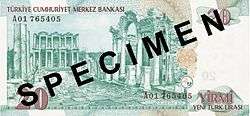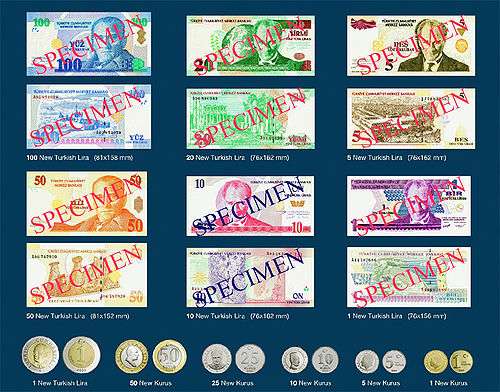Revaluation of the Turkish Lira
| Revaluation of the Turkish Lira | |
|---|---|
| Yeni Türk Lirası (Turkish) | |
|
New lira banknotes and coins | |
| ISO 4217 | |
| Code | TRY |
| Denominations | |
| Subunit | |
| 1/100 | new kuruş |
| Symbol | YTL |
| Banknotes | 1, 5, 10, 20, 50, 100 new lira |
| Coins | 1, 5, 10, 25, 50 new kuruş, 1 new lira |
| Demographics | |
| User(s) |
|
| Issuance | |
| Central bank | Central Bank of the Republic of Turkey |
| Website |
www |
| Valuation | |
| Inflation | 10.61% (Turkey, June 2008) |
| Source | Central Bank of the Republic of Turkey, Inflation report 2008-III |
|
This infobox shows the latest status before this currency was rendered obsolete. | |
The new Turkish lira (Turkish: Yeni Türk Lirası) was the currency of Turkey and the de facto independent state of the Turkish Republic of Northern Cyprus between 1 January 2005 and 1 January 2009 which was a transition period for the removal of six zeroes from the currency.[1] The new lira was subdivided into 100 new kurush (yeni kuruş). The symbol was YTL and the ISO 4217 code was TRY.
History
Because of the chronic inflation experienced in Turkey from the 1970s through to the 1990s, the old lira experienced severe depreciation. Turkey has had high inflation rates compared to developed countries and suffered hyperinflation. From an average of 9 lira per U.S. dollar in the late 1960s, the currency came to trade at approximately 1.65 new lira per U.S. dollar in late 2001. This represented an average inflation of about 38% per year. Prime Minister Recep Tayyip Erdoğan had called this problem a "national shame". With the revaluation of the Turkish old lira, the Romanian leu (also revalued in July 2005) briefly became the world's least valued currency unit.
| Economy of Turkey |
|---|
 |
| Economic history of Turkey |
|
Stock Exchange |
|
|
- 1966 — 1 U.S. dollar = 9 lira (TL)
- 1980 — 1 U.S. dollar = 0.0001 lira (YTL)
- 1988 — 1 U.S. dollar = 0.0018 lira (YTL)
- 1995 — 1 U.S. dollar = 0.0611 lira (YTL)
- 1996 — 1 U.S. dollar = 0.1075 lira (YTL)
- 2001 — 1 U.S. dollar = 1.4396 lira (YTL)
- 2004 — 1 U.S. dollar = 1.3421 lira (YTL)
- 25 July 2008 — 1 U.S. dollar = 1.21 lira (YTL)
- 6 November 2008 — 1 U.S. dollar = 1.6 lira (YTL)
- 18 July 2012 — 1 U.S. dollar = 1.81 lira (YTL)
- 15 April 2016 — 1 U.S. dollar = 2.94 lira (YTL)
In late December 2003, the Grand National Assembly of Turkey passed a law that allowed for the removal of six zeroes from the currency, and the creation of the new lira. It was introduced on 1 January 2005, replacing the previous lira (which remained valid in circulation until the end of 2005) at a rate of 1 new lira = 1,000,000 old lira.
The official name of the currency is "New Turkish Lira". According to the Central Bank, the word "new" (yeni) is only a "temporary" measure.[2] A news agency reported that "new" will be removed on January 1, 2009. The same source also indicated that the banknotes will have "different shapes and sizes to prevent forgery". The issuance of a new highest denomination, 200 lira, is contemplated at the same time.[3]
Coins
Coins were introduced in 2005 in denominations of 1, 5, 10, 25 and 50 new (Yeni) kuruş and 1 new (Yeni) lira. The 1 new (Yeni) kuruş was minted in brass and the 5, 10 and 25 new kuruş in cupro-nickel, whilst the 50 new kuruş and 1 new lira are bimetallic. All coins show portraits of Mustafa Kemal Atatürk.
To the dismay of the European Central Bank, the sizes and compositions of the 50 new kuruş and 1 new lira coins clearly resemble those of the €1 and €2 coins respectively. (See comparison photo in of YTL 1 coin and €2 coin.) This could cause confusion in the eurozone. It also caused trouble to businesses using vending machines (particularly at airports) in the eurozone since a number of vending machines at the time accepted the 1 new lira coin as a €2 coin. Since €2 is worth roughly four times more, vending machines affected had to be upgraded at the expense of their owners.
Banknotes
Banknotes, referred to by the Central Bank as the "E-8 Emission Group", were introduced in 2005 in denominations of 1, 5, 10, 20, 50, and 100 new lira. Whilst the lower four denominations replaced older notes and used very similar designs, the 50 and 100 new lira notes did not have equivalents in the old currency. All notes show portraits of Mustafa Kemal Atatürk from different points of his life and images of various historical and otherwise important buildings and places in Turkey. A new series of banknotes, the "E-9 Emission Group" will enter circulation on 1 January 2009, with the E-8 group ceasing to be valid after 31 December 2009 (although still redeemable at branches of the Central Bank until 31 December 2019). The E-9 banknotes will refer to the currency as "lira" rather than "new lira", and will include a 200 lira denomination.[4]
| Banknotes of Emission 8 | |||||||
|---|---|---|---|---|---|---|---|
| Image | Value | Dimensions | Main Colour | Description | |||
| Obverse | Reverse | Obverse | Reverse | ||||
 |
 |
1 lira | 160 × 76 mm | Claret Red, Blue | Kemal Atatürk | Atatürk Dam (as a part of Southeastern Anatolia Project) | |
 |
 |
5 lira | 162 × 76 mm | Pastel yellow and greenish brown | Kemal Atatürk | Anıtkabir, Ankara | |
 |
 |
10 lira | 162 × 76 mm | Red | Kemal Atatürk with Flag of Turkey silhouette | Piri Reis Map | |
 |
 |
20 lira | 162 × 76 mm | Green | Kemal Atatürk | Ruins of Ephesus | |
 |
 |
50 lira | 152 × 81 mm | Orange | Kemal Atatürk | Cappadocia | |
 |
 |
100 lira | 158 × 81 mm | Blue | Kemal Atatürk | Ishak Pasha Palace | |
| These images are to scale at 0.7 pixels per millimetre. For table standards, see the banknote specification table. | |||||||
| Current TRY exchange rates | |
|---|---|
| From Google Finance: | AUD CAD CHF EUR GBP HKD JPY USD INR |
| From Yahoo! Finance: | AUD CAD CHF EUR GBP HKD JPY USD INR |
| From XE: | AUD CAD CHF EUR GBP HKD JPY USD INR |
| From OANDA: | AUD CAD CHF EUR GBP HKD JPY USD INR |
| From fxtop.com: | AUD CAD CHF EUR GBP HKD JPY USD INR |
See also
References
- ↑ Official Gazette of the Republic of Turkey. "Law on the Currency of the Republic of Turkey".
- ↑ Central Bank of the Republic of Turkey. "Frequently Asked Questions on YTL". Retrieved 2006-09-28.
- ↑ Turkish Daily News (2006-09-15). "TL banknotes to be in circulation in 2009". Retrieved 2006-09-28.
- ↑ Türkiye Cumhuriyet Merkez Bankasi (Central Bank of the Republic of Turkey) (8 May 2007). "Announcement on the Withdrawal of New Turkish Lira Banknotes from Circulation". Official Gazette no. 26516, 8 May 2007, page 103. TCMB. Retrieved 2008-01-05.
External links
- Images of the new banknotes and coins
- Coins from Turkey with pictures
- (in Turkish) (in English) Turkish new lira official changeover Campaign
- (in Turkish) (in English) YTL information site
- (in Turkish) (in English) Ottoman Empire coins
- (in Turkish) (in English) Turkish Republic banknotes
- (in Turkish) (in English) Turkish Republic coins and banknotes
| Preceded by: First Turkish lira Reason: inflation Ratio: 1 new lira= 1,000,000 lira |
Currency of Turkey January 1, 2005 – December 31, 2009 |
Succeeded by: Second Turkish lira Reason: renaming Ratio: at par |
